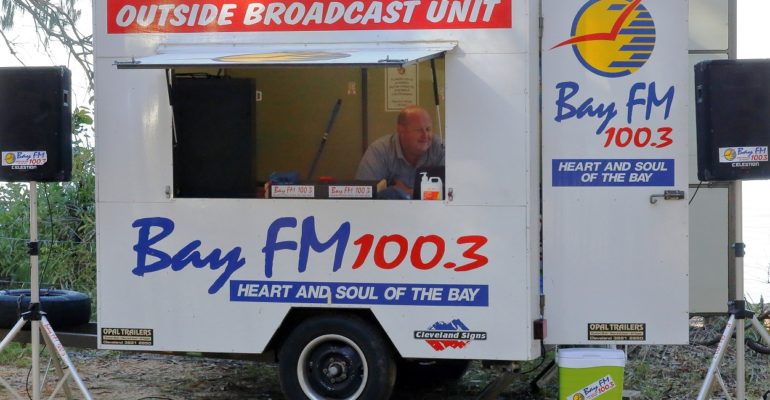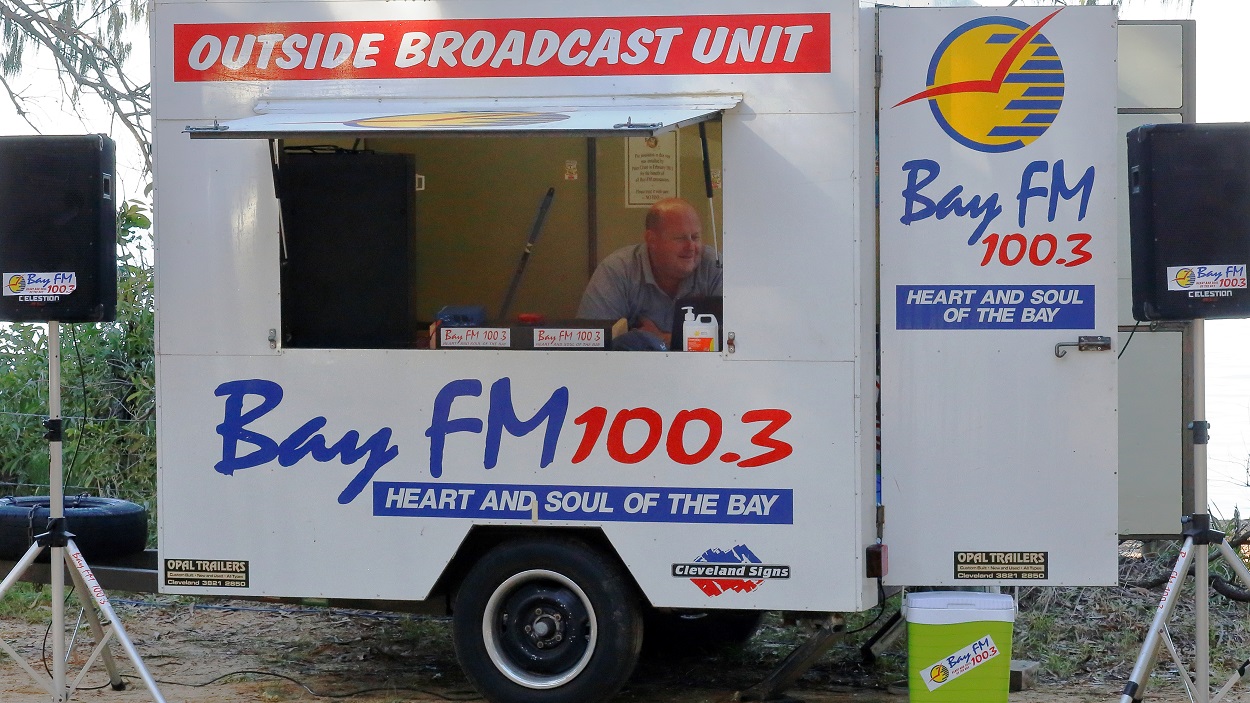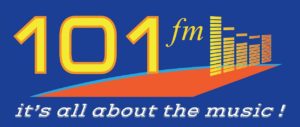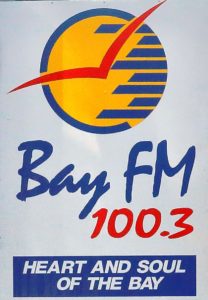

Community radio station Bay FM 103 doing an outside broadcast on Coochiemudlo
One of Australia’s best-kept secrets is the touch of a button away. It’s community radio and in the Redlands, it’s Bay FM 100.3, which began regular broadcasts in 1994. A hop, skip and a jump away is Logan’s own community station, 101.1 FM, on-air since 1988.
But what can these stations offer that other broadcasting services can’t?
Who’s listening to community radio

Logan City’s 101FM has a long established reputation as one of the leading community broadcasters in south east Queensland.
An annual audience survey conducted by respected market research firm McNair Ingenuity provides some of the answers. Top of the list for listeners is a desire to hear local news and information — stories that concern us directly rather than what seems an obsession with the machinations of George Street or Canberra.
Local audiences have also expressed a strong desire to tune in for specialist or Australian music rather than the formats that tend to dominate commercial FM radio. And listeners want to hear voices on air that are ‘like one of us’ or who sound ‘ordinary’, rather than the slick commercial banter that seems to stereotype commercial broadcasters.
So who’s listening? Nationally, more than five million people tune in to their local community radio station in an average week. In the Brisbane region that’s around 1.8 million listeners over the age of 15, filling a significant gap in audience needs that neither mainstream commercial nor public radio can achieve.
Serving local communities of interest

BayFM 100.3 prides itself on being entertaining and informative for the listening audience and local business community plus promoting a unique bayside lifestyle.
Bay FM and 101 FM are two of around 500 community radio stations in Australia with the largest proportion (41 per cent) in regional areas.
About one third of stations operate in metropolitan or suburban areas. Each operates as non-profit, funded largely by sponsorship, subscriptions and small grants from the federal government, administered by the Community Broadcasting Foundation (CBF).
Community radio was established in 1972 when Radio Adelaide became the first to be licensed in the country. An initiative of the Whitlam government, community radio was implemented during the Fraser years and has gone from strength to strength, now producing more than 90,000 hours of content each week in 100 different community languages.
The aim was to fill the gap in audience needs left by the commercial broadcasters, the ABC and SBS and it has most certainly done that. In many parts of Australia, a community radio station is the only local voice that communities can hear with most mainstream radio delivered by satellite from many hundreds or even thousands of kilometres away. It is the emphasis on local community that continues to define this vibrant sector of the Australian media and economy.
The key to community radio’s success has been pursuit of its prime objective — enshrined in the Broadcasting Services Act — of serving local communities of interest. This is enormously varied and includes young people, seniors, the arts, Australian sport, education, local groups and associations as well as offering specific access for ethnic, Indigenous, religious communities and people with print disabilities.
Despite this challenge, 25,000 people across Australia regularly volunteer to keep this important sector running and in return, receive various levels of training in media administration and production. Many of Australia’s best-known broadcasters had their start in community radio.
Australian Communications and Media Authority
So who listens? In the Brisbane region, 28 per cent of radio listeners over the age of 15 tune in to their local community radio station for 14 hours a week, mostly during the day. Slightly more men than women (54/46) are listeners but significantly for sponsors, almost 80 per cent of these are the main grocery buyer in a household.
Around 70 per cent of community radio listeners are either employed or engaged in home duties and of these, 40 per cent have an income of more than $60,000 per year.
Community radio broadcasts under the watchful eye of the Australian Communications and Media Authority (ACMA) and two self-regulating industry bodies — the Community Broadcasting Foundation (CBF) and the Community Broadcasting Association of Australia (CBAA).
All stations are expected to operate under an agreed industry code of practice that covers issues such as program sponsorship (a maximum of five minutes per hour), the need to provide adequate training for volunteers, and an obligation to encourage participation in program production by those in the community not adequately served by other media.
Access to broadcast time cannot be linked to sponsorship under this code.
A valuable cultural resource.
From its humble beginnings 45 years ago, community broadcasting has become Australia’s largest independent media sector. It provides audiences with a high level of satisfaction in services unobtainable from either commercial or public broadcasters like the ABC or SBS: try contacting a mainstream broadcaster with an idea, comment or complaint!
Community radio’s greatest strength is its ability to establish and sustain strong links with its own specific communities of interest, providing audiences with local news and information unavailable from mainstream sources — a valuable cultural resource.
Michael Meadows – 23 January 2018
Useful links:
- Australian Communications and Media Authority —community broadcasting (2017)
- Community Radio Broadcasting Codes of Practice (2017):
- Community Broadcasting in Australia (2010)
- McNair Ingenuity community radio audience survey (2016):
Please note: Offensive or off-topic comments will be deleted. If offended by any published comment please email thereporter@redlands2030.net
One Comment
I heard last year that Bay FM was paying John Laws to come on air for 1-2 hours each day. I am not a radio buff anyway but when I heard this I decided not to even try it. I had enough of John Laws 30, 40 and 50 years ago – very self-opinionated and you cannot believe anything he advertises because it is simply cash for comment.